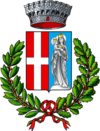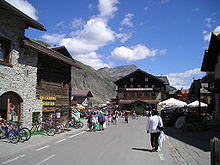Livigno
| Livigno | ||
|---|---|---|

|
|
|
| Country | Italy | |
| region | Lombardy | |
| province | Sondrio (SO) | |
| Local name | Livign | |
| Coordinates | 46 ° 32 ′ N , 10 ° 8 ′ E | |
| height | 1816 m slm | |
| surface | 211 km² | |
| Residents | 6,769 (Dec. 31, 2019) | |
| Population density | 32 inhabitants / km² | |
| Factions | Trepalle | |
| Post Code | 23030 | |
| prefix | 0342 | |
| ISTAT number | 014037 | |
| Popular name | Livignaschi | |
| Patron saint | Santa Maria ( September 8th ) | |
| Website | Livigno | |
Livigno ( Lombard Livign , Romansh or Lavin da Buorm , German Luwin ) is a municipality in the Italian province of Sondrio in Lombardy with 6,769 inhabitants (as of December 31, 2019). The place is a customs exclusion zone of the European Union .
geography
Livigno lies at an altitude of 1816 m slm in the Livigno Alps and is a popular winter sports destination . It lies on the river Spöl (now also Italian Sun, formerly Aqua Granda ) flowing through Livigno Valley from south to north, with a dam on the Italian-Swiss border to Lake Livigno is dammed and then at Zernez in Engadine in the Inn and thus flows into the Danube. So the valley lies north of the watershed of the Alps.
Trepalle , a district of Livigno, is by its own account the highest permanently inhabited place in Europe at an altitude of 1907 to 2250 meters, on the Passo d'Eira . Most sources, however, assume that the Swiss hamlet of Juf in the municipality of Avers GR deserves this title. The theoretical dispute is based on the fact that the tallest houses in Trepalle are actually higher than those of Juf, but the deepest houses in Trepalle are over 200 meters lower than those of Juf. In addition, Juf - unlike Trepalle - forms a closed settlement. Generally, however, the nucleus of a settlement (Office building, church ...) is chosen as the reference point, otherwise many communities in the Alps due to more or less high above the village enthroned, some now inhabited all year round alpine settlements, Maiensässe could take this title in claim etc..
The neighboring communities are Pontresina , Poschiavo , S-chanf , Zernez and Zuoz (each in the canton of Graubünden) and Valdidentro in the Italian province of Sondrio.
history
The Livigno valley has been inhabited since 1000 AD, initially for strategic military reasons. In the 17th century, Livigno was granted legal and economic autonomy by the Graubünden rulers of the Valtellina . In 1805, Livigno was declared a duty-free zone by Napoleon because of its exposed and previously barely accessible location in winter , so that it can still be inhabited all year round. Austria-Hungary recognized these advantages in 1818. In 1910, Livigno's status was confirmed by Italy and finally by the European Community in 1960. Livigno does not belong to the customs territory of the Community according to Art. 3 Para. 1 CC . Naturally, smuggling always played a major role, as can still be seen today in the names of restaurants and hiking trails.
Since the place was cut off from the outside world for six months a year until 1951, it can be described as a fake exclave and was nicknamed Piccolo Tibet ("Little Tibet"). Since then, the Passo di Foscagno has also been cleared in winter and, apart from short breaks, Livigno can be reached all year round from the Italian side. The valley is also accessible from the Swiss road No. 28 between Zernez and the Ofen Pass through the Munt-la-Schera toll tunnel built in the 1960s and during the summer months from the Bernina Pass via the Forcola di Livigno pass road .
Part of the village was destroyed in the 1960s when the Lago di Livigno reservoir was built .
tourism
Winter sports play the decisive role in tourism in Livigno, even if attempts are made to attract tourists in summer with attractive mountain biking and hiking opportunities.
In winter there are 33 lifts with a total capacity of 46,460 people / hour, which open up 115 km of slopes. There are also 40 km of cross-country trails. Because arrangements are common from Saturday to Saturday, long traffic jams form on these days between the village and the entrance to the single-lane Munt-la-Schera tunnel during the winter season .
The center of Livigno is a pedestrian zone, but cars can use it to get to and from the hotels located there . Four free bus routes run in town all year round. In addition, there are numerous shopping tourists, especially during the summer and winter holidays and on Saturdays, who benefit from low prices on duty-free items. a. on alcoholic beverages, tobacco products, perfumes and fuels. Similar to Samnaun , the municipality of Livigno also levies its own small taxes on the otherwise duty-free products, but in contrast to the Swiss “competition”, no VAT is levied in Livigno .
Attractions
- MUS! Museo di Livigno e Trepalle, which has been open since December 22, 2015, shows ethnographic material that tells the peasant roots of Livigno and Trepalle and the dynamism that has led to the present. The building dates from the end of the 18th century and has some typical elements of the traditional Livigno houses, such as the sc'tua, the kitchen with the cendré (boiler room) and the milk processing room.
Sports
- On May 22, 2005, the 14th stage of the Giro d'Italia ended in Livigno with a victory for the Colombian Iván Parra .
- In 2005 the Mountain Bike World Championships took place in Livigno.
- The alpine skiers Giorgio Rocca and Roberto Nani come from Livigno.
See also
literature
- Martin Bundi: Livigno. In: Historical Lexicon of Switzerland . November 27, 2008 .
- Anna Ferrari-Bravo, Paola Colombini: Guida d'Italia. Lombardia (esclusa Milano). Milano 1987, p. 400.
- Lombardia - Touring club italiano, Touring Editore (1999), ISBN 88-365-1325-5 , Livigno Online
Web links
- Official websites
- Livigno (Italian) on tuttitalia.it/lombardia
Individual evidence
- ↑ Statistiche demografiche ISTAT. Monthly population statistics of the Istituto Nazionale di Statistica , as of December 31 of 2019.




